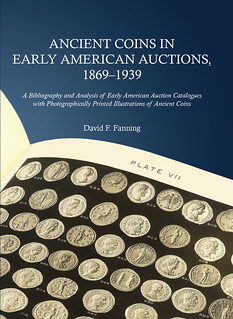
PREV ARTICLE
NEXT ARTICLE
FULL ISSUE
PREV FULL ISSUE
REVIEW: ANCIENT COINS IN EARLY AMERICAN AUCTIONSChristopher McDowell submitted this review of David Fanning's new book on ancient coins in early American auctions. Thanks! -Editor
A few weeks ago, I saw an advertisement to pre-order David Fanning's new book. I initially hesitated to do so because I have almost no interest in ancient coins. Still, my curiosity got the better of me, and I placed an order. I am delighted with my impulse decision. At the outset, I must say that one does not have to be a collector of ancient coins to enjoy David's book; however, I presume that if your collecting interest leans in that direction, the book will bring you even more enjoyment. Readers should not skip the book's introduction. The information contained there transcends the topic of ancient coin auctions; it presents a concise history of coin collecting and auction catalogs outside the scope specified in the book's title (the 1869 date in the title refers to the first illustrated ancient coin catalog to appear in America). David surveys the eighteenth-century American collecting scene and describes the history of coin auctions in America from the early 1820s to World War II. Much of the information presented in the introduction was new to me. In addition to an overview of the subject matter, David provides a detailed history of the changing technology for the production of numismatic auction catalog illustrations. While this may sound a dry topic, it is not. The information I learned in this section rises above ancient coins—it applies to every image of coins and medals that appeared during the period under consideration. At the risk of sounding ignorant, I was blissfully unaware that in 1897 the federal government determined that photography of U.S. coins ran afoul of anti-counterfeiting laws and that this prohibition remained in effect until 1904 when the Chapman Brothers successfully challenged it. As a result, there is a seven-year gap in the photographic record of American coin sales. There are many other such nuggets of knowledge contained in the introduction. Quite honestly, after reading just the introduction, I felt I had received my money's worth. After the introductory section, David looks at every significant cataloger in alphabetical order. He examines all the catalogs they produced containing illustrations of ancient coins. Plates from these catalogs containing ancient coins are beautifully reproduced, along with short biographical sketches of over a dozen catalogers. While the focus is on those auction catalogs in which ancient coins appeared, the biographies are comprehensive of all the major and some minor catalogers' lives. The information is presented in a well-written and thought-provoking fashion that effortlessly holds the reader's interest; which one would expect from an author with a Ph.D. in English. I admit that I started off intending to skip through the material but ended up reading every entry, even finding myself marveling at the plates of ancient coins. At the conclusion of the book is a compendium of statistical information and analysis of the auction material presented along with a listing of the author's opinion as to the top early American auction catalogs for ancient coins. Perusing this material made me long for a similar book comprising American Colonial coins. Hopefully, we will one day see additional numismatic series covered to the same thorough extent. I highly recommend David Fanning's new book to anyone interested in numismatics.
I've also had a chance to see David's book, and I heartily second Chris McDowell's observations. It's a substantial work of 279 numbered pages, nicely hardbound in blue cloth with a glossy dust jacket. The color photos are of high quality. As Chris noted, the book's Introduction is a short but substantive overview of not only the importance of auction catalogs in determining provenance, but also of the history of coin collecting in America - two core topics that should be mastered by all serious collectors. The capsule biographies of major U.S. coin dealers are just as important - every serious American numismatist should acquaint themselves with these historical figures of the old school. The book includes some interesting but appropriate diversions from the main topic, such as Thomas Elder's c1909-1910 photos of his own collection of silver coins of Alexander the Great (p84-85). I agree there would certainly be a good market for books providing a similar roadmap to American Colonial coins as well as other popular topics in auction catalogs (such as medals and tokens). Many of the better auction catalogs in my own library came via my purchase of Donald Miller's library. He shared my interest in tokens, and this is reflected on the shelf to my right which includes a plated Bushnell sale and interleaved and plated copies of the 1865 and 1884 Levick sales. Congratulations to David Fanning for an important contribution to multiple fields: ancient coinage, American numismatic history, and the literature of numismatic literature itself. -Editor
To read earlier E-Sylum articles, see:

Wayne Homren, Editor The Numismatic Bibliomania Society is a non-profit organization promoting numismatic literature. See our web site at coinbooks.org. To submit items for publication in The E-Sylum, write to the Editor at this address: whomren@gmail.com To subscribe go to: https://my.binhost.com/lists/listinfo/esylum All Rights Reserved. NBS Home Page Contact the NBS webmaster 
|
